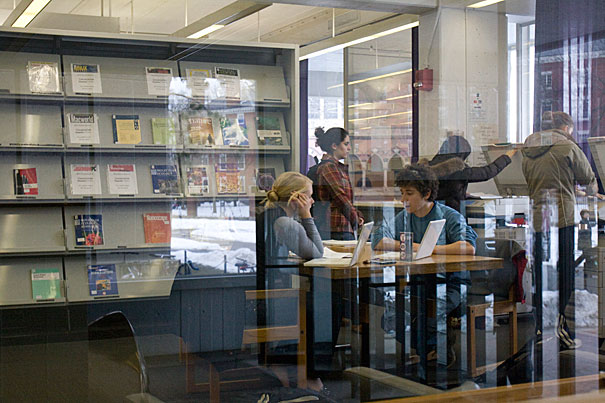
Re-imagining Cabot Library will bridge modern scholarship with the library’s traditional collections, and lead the way for increased cross-disciplinary cooperation to support the innovative teaching and collaborative learning of tech-savvy undergraduates.
File photos by Kris Snibbe/Harvard Staff Photographer
Cabot Library, re-imagined
Science Center facility to be renovated to meet future needs, blend into outdoors
The Science Center atrium and Cabot Science Library, already filled with bustling undergraduates, will undergo a transformation to support learning and teaching for the digital age while more effectively connecting the library to the atrium and plaza social spaces.
The redesign will support student life and align with the goals of Harvard’s Common Spaces initiative.
“The Cabot Science Library is ripe for re-imagining, and its prime location in the heart of the Science Center offers an opportunity to serve as an undergraduate teaching, learning, and research support hub for all the disciplines now requiring digital resources,” said Michael D. Smith, dean of the Faculty of Arts and Sciences (FAS).
The library serves as Harvard’s general science library, with emphasis on research collections in mathematics, statistics, earth and planetary sciences, psychology, and cross-disciplinary studies. In announcing the renovation, Smith said a faculty committee will be formed to provide input throughout the construction process. In addition, feedback from students and staff will help guide the project.
“To ensure that we make the most of this opportunity, the re-imagining of the library must be done thoughtfully, with input from faculty with a keen interest in undergraduate education, and from undergraduates themselves,” Smith said.
“How to meaningfully weave together information and space?” asked Jeffrey Schnapp, faculty director of the metaLAB at Harvard and chair of the faculty committee that will direct the renovations. “Traditional library structures have done this for tens of centuries, but in the midst of a media revolution comparable to the passage from scrolls to codices and manuscripts to print, we have the opportunity to model new visions of the library for the digital age. I see this as the core charge for the Cabot Science Library committee.”
This transformation of the Science Center atrium and Cabot Science Library is being sponsored by a generous gift.
“Science libraries are important spaces for collaboration, consultation, and community building, connecting people and information in service of creativity and discovery,” observed Sarah Thomas, Roy E. Larsen Librarian for FAS and vice president for the Harvard Library.
“Cabot Library is heavily used by undergraduates, not just science concentrators, but students from across the disciplines,” said Susan Fliss, associate librarian of Harvard College for research, teaching, and learning. “The process of designing the Cabot Library with input from a range of users allows us to better plan our integrated service offerings in cooperation with other academic support partners such as the Academic Technology Group, the Bok Center, and HUIT,” which stands for Harvard University Information Technology.
The renovation will include an examination of the library’s relationship to existing and future programs in the Science Center, possibly including a visualization lab and a digital media research commons. The programs are being designed to strengthen technology-based teaching, learning, and collaboration across disciplines from the sciences to the humanities. The project will redesign the atrium, which will enhance this central and highly utilized social space.
“Cabot Library has long served a vital role in providing access for our students and faculty to the journals and other works necessary for their scholarship. But technological advances have now changed the ways in which we access and use these materials, providing an opportunity to rethink how we use Cabot and the Science Center,” said Jeremy Bloxham, dean of the FAS Division of Science. “We envisage a center for technology-based learning that will allow our students and faculty to take full advantage of the digital resources that new technologies provide, not just for the sciences, but for scholarship in and across all areas of academic inquiry.”
Re-imagining Cabot will bridge modern scholarship with the library’s traditional collections, and lead the way for increased cross-disciplinary cooperation to support the innovative teaching and collaborative learning of tech-savvy undergraduates.
Lynne Schmelz, librarian of the Cabot Science Library, added, “The timing couldn’t be better for us to join forces to conceptualize the new Cabot Library. We are indeed fortunate that a generous gift will help us realize a 21st-century Cabot Library that supports integrated services and collections.”
The Science Center sits at the crossroads of Harvard Yard and the northern part of the campus. With its entrance just off the center’s busy atrium, the library is well-suited to be a social center and innovative learning and teaching space.
Cabot is also adjacent to the recently renovated Science Center Plaza, a popular area in the Common Spaces project that succeeded in bringing together students, faculty, and staff from across the University. The plaza has a weekly farmers market and will host dozens of local artists and designers from Boston’s SoWa Open Market over the next several Fridays.
FAS planning committees are in the process of selecting an architect, who will work closely with faculty and library staff as the project progresses.




